
Ayodhya is a city situated on the banks of the Sarayu river in the Indian state of Uttar Pradesh. It is the administrative headquarters of the Ayodhya district as well as the Ayodhya division of Uttar Pradesh, India.
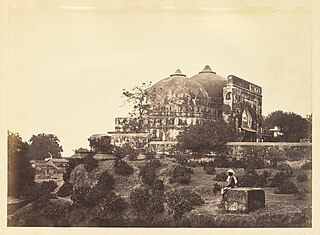
Babri Masjid was a mosque in Ayodhya, India, which many Hindus believe was built upon the site of Ram Janmabhoomi, the hypothesized birthplace of Rama, a principal deity of Hinduism. It has been a focus of dispute between the Hindu and Muslim communities since the 18th century. According to the mosque's inscriptions, it was built in 1528–29 by Mir Baqi, a commander of the Mughal emperor Babur. Before the 1940s, the masjid was officially known as "Masjid-i-Janmasthan". The mosque was attacked and demolished by a Hindu nationalist mob in 1992, which ignited communal violence across the Indian subcontinent.
Ram Janmabhoomi is the site that is hypothesized to be the birthplace of Rama, believed to be the seventh avatar of the Hindu deity Vishnu. The Ramayana states that the location of Rama's birthplace is on the banks of the Sarayu river in a city called "Ayodhya". Modern-day Ayodhya is in the north Indian state of Uttar Pradesh.

The Gorakhnath Math, also known as Gorakhnath Temple or Shri Gorakhnath Mandir, is a temple of the Nath monastic order group of the Nath tradition. The name Gorakhnath derives from the medieval saint, Gorakshanath, a yogi who travelled widely across India and authored a number of texts that form a part of the canon of Nath Sampradaya. The Nath tradition was founded by guru Matsyendranath. This math is situated in Gorakhpur, Uttar Pradesh, India within large premises. The temple performs various cultural and social activities and serves as the cultural hub of the city.
The archaeology of Ayodhya concerns the excavations and findings in the Indian city of Ayodhya in the state of Uttar Pradesh, much of which surrounds the Babri Mosque location.

The Ayodhya dispute is a political, historical, and socio-religious debate in India, centred on a plot of land in the city of Ayodhya, Uttar Pradesh. The issues revolve around the control of a site traditionally regarded among Hindus to be the birthplace of their deity Rama, the history and location of the Babri Masjid mosque at the site, and whether a previous Hindu temple was demolished or modified to create the mosque.
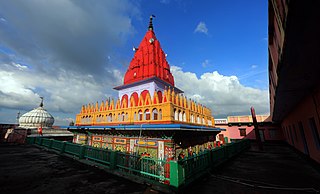
Hanuman Garhi is a 10th-century Hindu temple of Hanuman in Uttar Pradesh, India. Located in Ayodhya, it is one of the most important temples in the city along with other temples such as Nageshwar Nath. This shrine is under the charge of Bairagi Mahants of Ramanandi Sampradaya and Nirvani Akhara.

Mahavir Mandir is a Hindu temple dedicated to the god Hanuman, located in Patna, Bihar, India. Millions of pilgrims visit the temple every year. Acharya Kishore Kunal is the secretary of the Mahavir Mandir Temple Trust, Patna.
Keshava Parasaran is a lawyer from India. He was Advocate General of Tamil Nadu during President's rule in 1976, Solicitor General of India under the then Prime Minister Indira Gandhi and then, Attorney General of India under Prime Ministers Indira Gandhi and Rajiv Gandhi between 1983 and 1989, till the end of Rajiv Gandhi's tenure. Parasaran was awarded the Padma Bhushan in the year 2003 and Padma Vibhushan in the year 2011. In June 2012, he received a presidential nomination to the Rajya Sabha, the upper house of India's parliament, for a period of six years. He is a member of Shri Ram Janmabhoomi Teerth Kshetra. In 2019 the Central Government appointed him to lead the Shri Ram Janmabhoomi Teerth Kshetra. However later, Mahant Nritya Gopal Das was appointed to lead the trust. The trust oversees the construction of Ram Temple in Ayodhya.
Kishore Kunal is a former officer of the Indian Police Service from the state of Bihar, India. During his police career, he was appointed as the Officer on Special Duty (Ayodhya) by the prime minister V. P. Singh to mediate between the Vishwa Hindu Parishad and the Babri Masjid Action Committee on the Ayodhya dispute. He continued to serve in this position during the premierships of Chandra Sekhar and P. V. Narasimha Rao.

The demolition of the Babri Masjid was carried out on 6 December 1992 by a large group of activists of the Vishva Hindu Parishad and allied organisations. The 16th-century Babri Masjid in the city of Ayodhya, in Uttar Pradesh, India, had been the subject of a lengthy socio-political dispute, and was targeted after a political rally organised by Hindu nationalist organisations turned violent.
The Akhil Bharatiya Akhara ParishadABAP, one of the organizations of Hindu sants (saints) and sadhus (ascetics) in India. The ABAP is composed of 14 akharas, or organisations of Hindu sants and sadhus. Nirmohi Akhara and Shri Dattatreya Akhara are two of the prominent akharas which are part of it.
Ram Janmabhoomi Nyas is an organisation which was formed as a trust to promote and oversee the construction of a temple in Ayodhya, India at the Ram Janmabhoomi, the reputed site of the birth of Rama, the seventh and one of the most popular Avatars of Hindu God Vishnu. The Nyas was formed by members of the Vishva Hindu Parishad.

The Ram Rath Yatra was a political and religious rally that lasted from September to October 1990. It was organised by the Bharatiya Janata Party (BJP) and its Hindu nationalist affiliates, and led by the then-president of the BJP, L. K. Advani. The purpose of the yatra was to support the agitation, led by the Vishwa Hindu Parishad (VHP) and its affiliates in the Sangh Parivar, to erect a temple to the Hindu deity Rama on the site of the Babri Masjid.
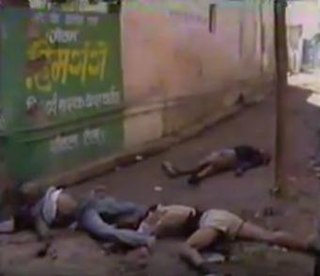
The Ayodhya firing describes the occasion when the Uttar Pradesh police opened fire at civilians because they were heading to demolish the Babri Masjid on two separate days, 30 October 1990 and 2 November 1990, in the aftermath of the Ram Rath Yatra. The civilians were religious volunteers, or kar sevaks, assembled near the Ram Janmabhoomi site at Ayodhya. The state government's official records report that at least 17 people were killed.

The final judgement in the Ayodhya dispute was declared by the Supreme Court of India on 9 November 2019. The Supreme Court ordered the disputed land to be handed over to a trust to build the Ram Janmabhoomi temple. The court also ordered the government to give an alternative 5 acres of land in another place to the Uttar Pradesh Sunni Central Waqf Board for the purpose of building a mosque as a replacement for the demolished Babri Masjid.
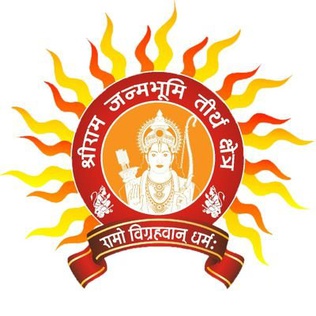
Shri Ram Janmabhoomi Teerth Kshetra is a trust set up for the construction and management of Ram Mandir in Ayodhya by the Government of India in February 2020. The trust is composed of 15 trustees.
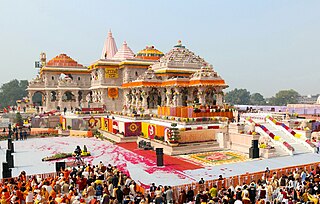
The Ram Mandir is a Hindu temple under construction in Ayodhya, Uttar Pradesh, India. It is located at the site of Ram Janmabhoomi, the hypothesized birthplace of Rama, a principal deity of Hinduism.

Champat Rai is an Indian politician, Leader and Vice President of Vishva Hindu Parishad, and currently serving as the General Secretary of Shri Ram Janmabhoomi Teerth Kshetra.

Ram Mandir Prana Pratishtha refers to the consecration ceremony of the Ram Mandir which was held on 22 January 2024. The event was organized by Shri Ram Janmabhoomi Teerth Kshetra.













